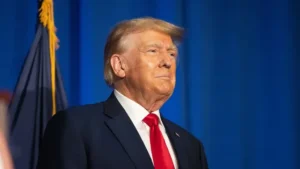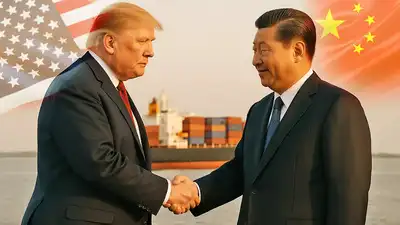Mr. Trump claimed that “unacceptable levels” of illegal substances, including fentanyl, are being trafficked into the US and that import levies will compel other nations to combat the trafficking.
Mr. Trump claimed in a Truth Social post on Thursday that illegal drugs, including fentanyl, are being imported into the US at “unacceptable levels” and that import levies will compel other nations to take action against the trafficking.
The Republican president wrote: “We cannot allow this scourge to continue harming the USA, and therefore, the proposed TARIFFS scheduled to go into effect on MARCH FOURTH will, in fact, go into effect, as scheduled, until it stops, or is seriously limited.” “On that date, China will also be subject to an additional 10% tariff.”

The world economy has already been rocked by the potential of more tariffs, and consumers are worried that if Trump hikes import levies, inflation will accelerate and the auto industry and other American manufacturers will suffer.
However, Mr. Trump has also occasionally acted aggressively only to provide last-minute reprieves. For example, he previously consented to a 30-day delay of the tariffs that were originally scheduled to begin in February on Canada and Mexico.
The S&P 500 index dropped 1.6% on Thursday as the stock market was alarmed by the prospect of tariffs. The S&P 500 has lost nearly all of the gains that the president once said were proof of an economic recovery, and it is currently only 1.4% higher than it was following Mr. Trump’s election victory in November.
“It’s a myth,” Mr. Trump said in response to a question on Thursday regarding the fact that import businesses and consumers bear the majority of the cost of tariffs.
A higher US dollar might be able to partially offset the costs of tariffs, but considering the scope of Trump’s proposed taxes, his assertion defies most economic models.
Mr. Trump plans to impose 25% tariffs on Canadian and Mexican imports while imposing a 10% levy on Canadian energy supplies like electricity and oil.
Mexico and Canada responded to the move, which was supposedly about immigration and drug trafficking, by highlighting their current initiatives to address these problems.
Mexico deployed 10,000 soldiers of its National Guard to its border with the United States, and Canada established a fentanyl czar.
Claudia Sheinbaum, the president of Mexico, stated on Thursday that she intended to meet with Mr. Trump following this week’s Cabinet-level discussions in Washington.
On Thursday afternoon, Secretary of State Marco Rubio was to meet with Juan Ramón de la Fuente, the Foreign Affairs Secretary of Mexico.
Ms. Sheinbaum stated that Mr. Trump “has his way of communicating, as you know.” However, she stated that her administration would remain “calm” and hopeful that a deal would be reached to evade the penalties.
“I’m hoping we can come to an agreement so we can make an announcement on March 4th,” she stated.
According to her, the security leaders of Mexico and the United States were debating intelligence cooperation that would enable significant arrests in the United States.
Regarding the economy, she stated that Mexico wants to preserve the free trade agreement between the United States and Mexico that was negotiated during the first Trump administration. The North American Free Trade Agreement from 1994 was updated in that 2020 agreement, which also included Canada.
According to his social media post, Mr. Trump did put a 10% duty on China for its involvement in the production of chemicals used to create fentanyl, and that charge would now be doubled.
In a letter to Jamieson Greer, the recently appointed U.S. trade representative, China’s Commerce Minister Wang Wentao stated on Thursday that trade disputes should be settled by discussions and agreements.
Jacob Jensen, a trade policy expert at the center-right think tank American Action Forum, estimates that the 25% tariffs on Canada and Mexico would result in an annual tax hike for the American people of between $120 billion and $225 billion. Up to $25 billion may be lost by consumers as a result of the new China tariffs.
As part of his reciprocal tariffs, Mr. Trump said on Wednesday that European nations would also be subject to a 25% levy. In addition to the reciprocal duties, he wants separate levies to be imposed on pharmaceuticals, computers, and automobiles.
In addition to planned levies on copper imports, the president has already said that he is eliminating the exemptions from his 2018 steel and aluminum tariffs.
U.S. consumers are already becoming alarmed by the possibility of a wider trade war if other countries implement their own retaliatory tariffs, which might jeopardize Trump’s pledge to spur faster economic development.
On Tuesday, the Conference Board said that its consumer confidence index had fallen 7 points to 98.3. Since August 2021, when inflationary pressures started to ripple across the United States as the economy recovered from the coronavirus outbreak, it was the biggest monthly fall. According to the Conference Board, average 12-month inflation estimates increased from 5.2% to 6% in February.



